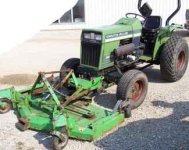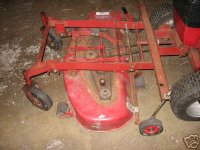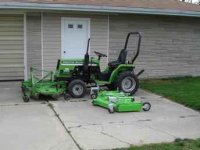brandoro said:
One thing I was concerned about was the "punji stick" problem. Cutting higher on the first pass should work, then driving through the cut afterwards the tires would push the stumps over instead of climbing up on the cut ends.
I got a few flats and ruined a new tire once due to punji sticks.
Since I started cutting new areas "high" the first time I have gone well over 5 years with no flats except for the new tire I ruined when some fencing help cut a small tree a couple inches above the ground and I ruined a sidewall of a new tire on my Dakota.
Of course they said "we didn't do that" and I asked how they supposed the fresh sawdust happened to be there and they got quiet.
That, and some locust thorns gave me some slow leaks that were a bother before I started using Slime in my tractor tires. Tractor flats on the rear tires are $50 to fix if you take it to them. After I bought $100 dollars worth of punji stick repairs on the rear tractor tires I got pretty religious about mowing a foot high on the first pass, waiting a season and going back at them.
I drive all though my pastures with 3 different pickups and my tractor and except for the fence project problem I have never damaged a tire on cut off brush and trees since starting the "cut high the first time" program.
When I cut a brushy area for the first time, if the brush is too heavy (large in diameter) so that from experience (bad) I know not to drive over it going forward. I raise the mower to cut a foot high and back through it. Works great. On larger trees up to 4-5 inches in diameter I raise the cutter all the way and tilt it up with the hydraulic top link and slowly back up to the tree with engine making revs for PTO speed of 540. After engaging the tree I slowly lower the cutter to within a foot or so of the ground, sometimes backing and pulling back forward a bit while the cutter is chewing up and spitting out the tree.
If you get too aggressive (and sometimes even if you don't) you can kill the engine. Sometimes the action shakes the whole tractor more than just a little bit. I got 6 years out of the first set of blades and only sort of sharpened them just once. They beat things apart as much as cut them. This tends to make the cut ends into what looks like a handful of toothpicks instead of a sharpened pungi stick. Finally a blade failed at the pivot hole and I bought a new set. Still 6 years of abuse is pretty good return on investment.
If brush is small enough in diameter and strength that you can slowly back over it with the cutter over a foot in height and then lower it to a foot, you can cut some pretty dense brush. The only down side for me is getting a sore neck from all the backing. I have learned to turn my body as far as possible and then the neck. For young supple (pre-arthritic) guys it will be no problem.
Way cheaper to use reverse than start an expensive quest/project for a front mounted mower. It would be cheaper to buy a DR type brush mower (not the little string trimmer type on steroids) and hook it to the front of the tractor.
Pat




